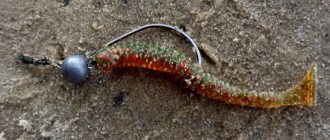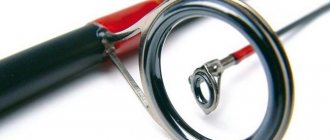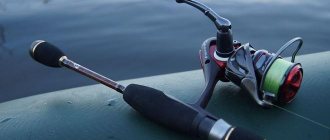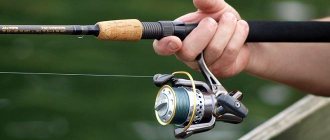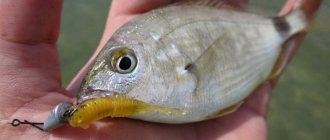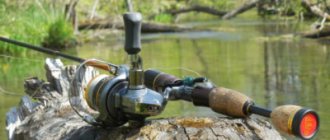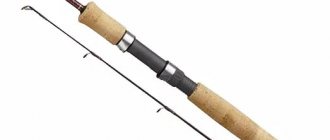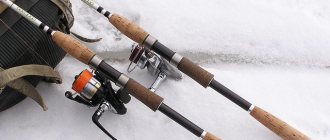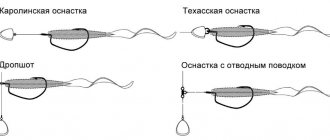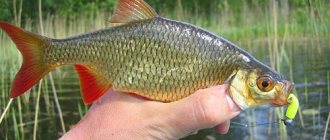Andrey Pitertsov: KILLED LEAGUE. ULTRALIGHT CLASS
Spinning fishermen are probably some of the most creative people in the fishing world. They are constantly looking for something, experimenting with something... Either they are exploring new fishing spots, or they are looking for the most catchy bait, the most sensitive spinning rod... The search never ends. And the most favorite baits are sent to a separate, “privileged” box to participate in subsequent “battles”. It is this echelon that is the first to go into battle as soon as the fisherman finds himself on a new body of water; it is they who bring the long-awaited victory to sports fishermen...
I also have “secret” boxes. It is very difficult for baits to get into them. They should show themselves better, or at least no worse than the “favorite of these places,” but this is not enough. Only under one condition does an instant admission to the elite division occur - excellent performance in competitions. Of course, in addition to the bait itself, there are many other factors: the manner and options of posting, the selection of fishing line, the choice of gear... But often, with all this we can only improve the excellent performance of the bait itself.
I would like to talk about the most effective baits and tackle of the past season. Which helped me win prizes at competitions not only in 2007, but also earlier. In short, this review includes the best of the best. I hope you will appreciate them too...
Features of mini-tackle
Classification of ultralight wobblers by buoyancy:
- Floating near the surface (floating).
- Sinking
- Independent buoyancy (suspending).
Each bait has its own code, so they can be easily distinguished from each other. The numbers that are located immediately after the brand designation indicate the length in millimeters. If the designation consists of one digit, then the length is indicated in centimeters.
Next is a marking of letters characterizing the behavior of the wobbler in water.
Let's look at some of them:
- SS – slowly sinking (Slow Sinking);
- EX or FX – sinks quickly (Extra Sinking or Fast Sinking);
- SF – Slow Floating.
It should also be noted that the depth at which the bait goes also has its own marking:
- SSR – goes almost to the surface at a depth of 5 to 10 cm (Super Shallow Runner);
- SR – dives up to 50 cm (Shallow Runner);
- MR – medium depth, up to 1 meter (Medium Runner);
- MDR – deepens from 1.2 to 1.5 meters (Mediun Deep Runner);
- DR – deep, up to 2 meters (Deep Runner).
Of course, the depths shown are averages and are subject to change.
Ultralight wobblers are an exact copy of their predecessors, only much smaller.
The best ultralight wobblers:
ZipBaits Rigge 35F
Probably only a lazy fisherman does not know this wobbler, which has already become a kind of legend. But if he didn’t catch it himself, he at least heard rave reviews. This bait was repeatedly mentioned in articles, and only thanks to this wobbler were competitions won!
And I have no choice but to agree with all the positive reviews regarding “Ridge”. It is good, first of all, for its versatility. In addition to the fact that it is the undisputed leader in the “perch twitching” class, “Ridge” showed itself well when catching chub and asp on a regular retrieve or with small jerks. And this is a very powerful argument for a wobbler!
It is this wobbler that is the first to go to explore a new place. There are other wobblers that, under certain conditions, may out-catch the Rigge 35F, but none has ever been as good in any place and at any time of the year (when fishing for perch) as the 35 Ridge. Its average working depth is 30-40 cm.
All that I could remember from the “specifics” of the competition sounds like this: Dmitrov championship - 2005 - first place (about 40% of the perch were caught with this wobbler, the rest with a microjig); Moscow perch - 2006 - a confident victory of Denis Vikhrov and Anatoly Nazarkin (all fish were caught on Rigge 35F and Rigge Deep35F). And these are just victories, and how many more places are in the top three...
Smith D-contact 50mm
Long-range, fast-sinking minnow. It catches very well, including inactive perch, which it simply lures out of cover and literally forces it to attack. I would never have thought that a wobbler with such characteristics would combine searching for fish and catching it so well. It works well only with constant aggressive twitching. If you pause in the retrieve, the wobbler quickly begins to sink. So quickly that the perch following him begins to flee (in clear water this is clearly visible). Therefore, when fishing for perch in still water, the best retrieve is monotonous jerks throughout the entire retrieve. At the same time, the working horizon of the wobbler is 2-2.5 m, which makes it a leader in high-speed perch fishing. It catches trout very well, but only when it comes to fishing in pits.
As for victories. Repeatedly brought prizes to Maxim Dydykin, Andrey Mikheev, Dmitry Tretyakov on the reservoirs of the Saratov region. It was here that for several seasons this wobbler was the undisputed favorite of some athletes.
Jackson Komachi F
Length 45 mm, weight of the floating model 2.5 g. Working horizon 25-40 cm. With strong jerks on a braided line, it deviates very well from the original trajectory of movement, which is never left unnoticed by the perch. Excellent wobbler. It’s difficult to say in advance whether it will perform better or worse on a new body of water; it needs to be “tested by combat”... At least in some conditions it turned out to be a clear favorite. Trout also responds well to it, both in fisheries and wild reservoirs. By the way, when fishing for trout it is better to use monofilament. Not because trout are shy, but because of the specific manner of animation in which this wobbler performs best. The most effective wiring is very soft twitching with chaotic jerks, but without pauses. Maybe many will not agree with me, but it seemed to me that this particular wiring brings more bites.
From statistics: at the qualifying competitions for the 2007 World Championship, which took place on a paysite in the Leningrad region, about 30% of the trout were caught on the Komachi, and the bite was very capricious... This same wobbler became Alexander Vorobyov’s favorite during the training days before World Championships in Slovakia. Unfortunately, Alexander himself did not compete, but if he had been allowed to play, I am sure that he would have caught more than half of the trout with his beloved Komachi and would have taken his rightful place!
ZipBaits Rigge 56 S
Not a wobbler, but a legend! This is the “comrade in arms” you can rely on completely and completely. For a long time I tried to hide its existence and active use... It has already brought me many unforgettable competitions and titles, but now it’s time to show my cards.
This is exactly the wobbler, thanks to which I, as part of the MSRK team, won the title of Russian champion in 2006, at the same time becoming vice-champion in the individual competition. This wobbler caught 15 perches with 20 casts (as Maxim Balachevtsev put it, sneaking a peek through the reeds), at a time when similar wobblers caught 4-5 out of 20 casts in the same place!
For two seasons now, it has been my absolute favorite in the clear waters of the Volga (in the Saratov area). And when it is necessary to fish with a wobbler at a depth of 70-80 cm, without even thinking, I use it, with full confidence that it will outperform any of its analogues. This happened in 2006 and 2007. About 40-50% only thanks to the Rigge 56S I managed to win second place at the qualifying competitions for the World Championships in the Saratov region.
He has a lot of merit in catching trout on paid platforms; I caught about 30% of the fish at the qualifiers in the Leningrad region on this “Ridge”.
With this wobbler, when catching “striped”, I use only braided line. The best wiring: 4-5 strong “tempo” jerks, then a second pause, and the cycle repeats. When fishing for trout on a platform, use soft, chaotic twitching and only monofilament.
I tried this wobbler on reservoirs near Moscow - nothing special, it catches, but about on par with the others, apparently, the size is just too big for our conditions, but for the Volga it is beyond praise.
MM Minnow 38 F
It looks like a classic micro-minnow with minimal play of its own, which works well only on jerks of varying strength (working horizon - up to 30 cm). This is not entirely true. At times, this small wobbler shoots so hard that it “gives a light” to everyone without exception...
It’s difficult for me to explain why this happens, and it’s also difficult to say on which bodies of water it will be the best. This can only be known experimentally.
In 2005, at the competitions held on the canal, only thanks to this wobbler, the Vympel team took first place with a significant advantage. A day later, I and the winners arrived at the same place. The guys immediately started fishing with the MM Minnow 38F, and I set out to find a wobbler that worked at least as well. As a result, I was able to catch it only towards the end of the fishing trip, out of desperation I installed the same wobbler. After which the guys decided to change MM to others - the situation changed to the opposite - their perch completely stopped biting...
Tackle House Twinkle 45 F
Classic trout “wood”... Almost the most expensive! In some stores the price for it exceeds the thousand ruble mark. Previously, I did not understand it, as it seemed to me then, to be overpriced. I didn’t understand until one incident during the World Trout Fishing Championship in Slovakia in 2007. At one of the training sessions, Maxim Balachevtsev, by simply sorting through it, got what was then a “simply expensive” wobbler. Literally half an hour later, Alexander Vorobyov and I realized that if we fish with wobblers during the competition, it should be Twinkle... The next day or two I tried to refute this theory, but in vain. Thus, before the start, Maxim had to share one Twinkle... Fortunately, he had several of them. And I only had a Twinkle Deep Dive 45F, which, by the way, I fished with throughout the second day of the competition. On the very first day I fished almost all the time with the shallow-water model of this wobbler. Why is this so? The answer is simple: on the first day I got a shallow water zone, and on the second they expected a depth of up to 1.5 m.
I don’t presume to speculate on what the secret of this wobbler is, I’ll just say that the material from which Twinkle is made leaves its “imprint” on its performance characteristics. It has a very fast start (you can play on the spot even with a weak current) and very active play with soft twitching. This is just a visual feeling of how everything really happens, it’s probably worth asking the trout.
And finally - one very interesting pattern. In addition to the 45th model, we had several 60 mm long wobblers. And what is very strange is that only large trout (from 400 g) pecked at them. During the last day of training, we managed to catch several decent fish with them. And 20 minutes before the end of the first round (when I tore off the only 45 “Twinkle”), having placed the 60, on the second retrieve I got a bite from a trout weighing about a kilogram. This is where the experiment ended: I never saw a wobbler or a trout again...
Megabass X-55 SP
This wobbler captivated everyone: both anglers and perches and pikes. First of all, with its “maximum realism” in movements and “depth” of colors. Back in 2005, as soon as this model went on sale, I appreciated it. And even then he actively used this wobbler at various competitions. And in 2006, at the Russian championship, I caught at least a quarter of the total catch with it. Largely thanks to him, our team became the national champion.
It looks like a very classic minnow shape, a small blade, attractive colors. Very standard combinations, right? Apparently, all the most interesting things are hidden from human eyes. Otherwise, how else can we explain the phenomenal catchability and its superiority over other models in some situations. It is probably the thoughtfulness of every detail that distinguishes Megabass products.
You should pay attention to one important detail. Hundreds of perches have been caught with it, the tees are still original, and there is no desire to replace or sharpen them, they have retained their original sharpness.
Smith Luna 47S
Another well-known model that has long won the genuine sympathy of spinners. With monotonous twitching in still water, the working horizon of this wobbler ranges from 0.8 to 1.2 m. When retrieving with pauses, it can go a little deeper. In addition to perch, trout fishing is very good. These are precisely the two directions in which the working qualities of this model are most fully revealed.
I also noticed that if there is a pike in the fishing area, no matter what size, the reaction to the wobbler will, as a rule, be positive. The same cannot be said about the vast majority of other microwobblers.
It is the sinking version that works very well in the rapid flow of a mountain river. A small shoulder blade combined with decent weight and a strong body do the job. This wobbler is very, very attractive for trout. At the World Championships in Slovakia, his hands did not reach him, but during training he was selected for the “killer box”. Works well in combination with monofilament and soft twitching.
But as for perch, Luna still has more victories (at least for me). I caught 30 percent of the total mass of perches at the Moscow Dawns - 2006 competition with it. And he became the first. And if you consider that the remaining 70% were caught exclusively with jigs... It was thanks to “Luna” that Maxim Dydykin climbed to the podium at the 4th stage of the RSL Top Division in 2005.
My best and catchiest minnow wobblers for ultralight
Wobbler minnow (minnow) Rigge 35
First of all, of course, this is the Rigge 35 wobbler from Zip Baits (photo 13). Anglers have rather mixed opinions on this wobbler, but as a wobbler for a beginner that will help them master ultralight fishing, it is simply irreplaceable. The advantages are expressed in the fact that, firstly, the Rigge 35 wobbler has its own “game”. And secondly, you can master jerk wiring with it, because It also responds well to this type of animation. Well, good flight characteristics.
The Rigge 35 wobbler is available in five types: simply floating (weight 2 g), floating diving (weight 2.2 g), slowly sinking (weight 2.2 g). Not long ago, Rigge 35 appeared with a sound effect, i.e. with a special acoustic chamber. They are designated on the packaging as “Rattler In!” and are currently available only in floating (2.0 g) and slowly sinking versions (2.2 g - photo 14).
In general, the choice is very worthy for almost any of the most common ultralight fishing conditions. One of the disadvantages of this wobbler, which previously tormented anglers, is the tees. They were beardless and thin. A medium-sized fish simply straightened them out. And the absence of beards sometimes reduced an almost won fight to defeat, because... at the last moment the fish managed to land almost at our feet. At the moment the problem with the tees has been resolved. Now they have beards and are made of thicker wire.
The company offers about three dozen color solutions, if not more. But I advise you not to spread yourself too thin - and when choosing Rigge 35 wobblers, and not only these, but in general, act according to an algorithm that has proven its effectiveness more than once. This algorithm consists of three points:
— natural coloring for fry;
- dark color for insects;
- a bright provocateur color.
As you can see, nothing complicated. To begin with, it’s enough to buy two wobblers per color. Why am I suggesting this? Yes, so that later it would not be excruciatingly painful for wasted time. After all, if we break off one catchy wobbler, we will always have a second one in stock - and we can quite confidently continue fishing. Somewhat expensive, of course, but real art requires material sacrifices. However, to begin with, you can, of course, get by with one unit per color. And then buy the lost one...
If you suddenly firmly believe that color is not the most important component in a micro wobbler, then I don’t want to dissuade you, and I won’t. But believe me, the color of an ultralight wobbler is one of the important components - and often it, and only it, can radically change the fishing result. However, you will be able to verify this yourself more than once or twice.
Minnow wobbler Tiny Fry 38 from Jackall Bros
The second, no less popular minnow class wobbler is the Tiny Fry 38 from Jackall Bros. (photo 15). It has its own “game,” but it’s not at all the same as Rigge’s—it’s less pronounced. But for twitching - an excellent choice! The wobbler is very catchy, but there is a fly in the ointment here: the front tee often gets overwhelmed in front, located between the blade and the nose loop of the wobbler (photo 16). This happens even more often if we use a leash with this wobbler. Sometimes it comes to the point that up to half of the casts are hopelessly spoiled. You can combat this scourge by removing the winding ring or changing the number of the front tee, which more or less helps. But keep in mind that such “tunings” can upset the balance of the ultralight wobbler.
The Tiny Fry 38 wobbler is available in floating, hovering and sinking versions. Weight of baits in order: 1.8, 2 and 2.1 g. There are also a very decent number of colors - there is room to choose. But don’t forget about the selection algorithm.
Wobbler minnow Sugar Minnow 40 from Bassday
The third minnow wobbler is the already mentioned Sugar Minnow 40 from Bassday (photo 17). Has two replicas: floating and sinking. The first weighs 1.7, the second - 2 grams. His own “game” is weakly expressed. But, as I noted earlier, I managed to fish with the floating version of direct fishing in the current. And the bite was very good. But now I practically don’t use a floating one, but I often use a sinking model of the Sugar Minnow 40 wobbler - casting further and more accurately. And twitching is much more pleasant to work with, and the level of wiring is somewhat lower - unlike floating. Flaws? Yes, it seems they haven’t been discovered yet. The coating is perhaps rather weak for pike teeth.
Wobbler minnow Craсk Jack 38
The fourth on the list is a minnow wobbler from the already well-known company Pontoon 21 called Craсk Jack 38 (photo 18). It is a smaller copy of Craсk Jack 48 and Craсk Jack 58, already known in our country (photo 19). So far it is impossible to find it on sale, although I hope for it to appear by the time the article is published. Due to the nature of my work, I was able to devote a lot of time to the pre-production sample. What is successful here is not only the price/quality combination, rich color solutions and three types of depth - SR, MR, DR. Moreover, these wobblers exist in both floating (F) and hovering (SP) versions, i.e. we get not 3, but 6 different wobblers, which seriously expands the scope of their application. Plus a magnetic system to achieve maximum casting distance. In general, everything is like with people.
Craсk Jack 38 is a fairly simple wobbler. And it is suitable for both the novice fisherman and the experienced one. The variety of allowed wiring is from simple straight-line to twitching and stop-and-go. In general, I think many will appreciate this wobbler.
Wobbler minnow Tiemco Trick Trout 35SP (Mighty Pepper 35SP)
I thought for a long time about which fifth number to include in the list. There are enough candidates, but I still chose the most interesting one. This is Tiemco Trick Trout 35SP (photo 20). Weight 2 g. One day he became a real discovery for me when in the fall he managed to make a very nice visit to him on the Oka. The “game” of this wobbler is such that it is suitable for fishing with almost any type and speed of fishing. And the size is ours! I think anglers will find a lot of discoveries with it. Yes, I almost forgot: the name I indicated from old memory no longer exists in nature. The wobbler was first taken out of production, but then hastily resumed. They changed the colors - now the palette, however, has become much poorer. In addition, they changed the old name to a new one: Mighty Pepper 35SP (photo 21).
U. L. Barygin (To be continued)
The best ultralight walkers:
Angler's Republic Rapid Pencil Type-1
There are two versions of this walker, which look no different. These are Pencil Type-1 and Type-2. Both are floating, only the first is 0.2 g lighter than the second, and is oriented slightly differently in the water. Type-1 lies almost entirely on the surface, while Type-2 only has its front part visible, like a loaded float. Hence the different properties. The second flies a little further, but it seemed to me that it was also a little more difficult to control. And the first one flies closer, but is easier to fly. There is one more drawback of Type-2 - with a small side wave (ripple), it tends to dive under it, which does not happen with Type-1. Based on all this, I am more impressed by the “first type”.
No matter how trite it sounds, the most effective wiring is the constant monotonous wagging of the walker from side to side. Try to avoid disruptions in the monotonous movements of the bait to the right and left, this will definitely negatively affect the accompanying predator. In theory, the situation should be the opposite: interest, pursuit, stop and then attack. But in practice, in 80% of cases, exactly the opposite happens. The predator turns around and swims away. This can be attributed to perch to a lesser extent. As a rule, they are chased by a pack, and, as a rule, until the “victorious end”.
Mikhail Kaledin opened my eyes to this bait when he and I were preparing for the next stage of the RSL, fishing in the same boat. Yes, this walker was biting, but at the same time, I caught just as much with wobblers. Everything changed when, on the first day of the fourth stage of the RSL in 2007 at the Volgograd reservoir, Alexey Markov “blown me to smithereens.” He fished with just this walker (Type-2 only), and I fished with minnow wobblers. On the second day, I turned out to be more prepared and borrowed Mikhail’s “cherished violin,” with which I caught more than half of the perches, becoming first after two rounds.
Smith Towadi
Length 43 mm, weight 1.8 g. This is the smallest, properly working walker that I have ever fished with. The bait is capable of getting you out of seemingly hopeless situations, when the perch is simply not visible, it does not react to wobblers, rubber, spinners, but you put the Towadi and right before your eyes the situation changes radically. Out of nowhere, keel waves appear from literally all sides. Moreover, the perch reacts to other surface baits, but much worse, and it is already very bad to hook the hooks.
Walker, according to the classics, works in the warmest water, and if you don’t need to cast far (this little guy flies only 15-20 m maximum), and the mood of the perch is far from perky, this micro-walker will catch everyone who is at least able to move a little fins towards him.
Thanks to this bait, Maxim Dydykin won a silver medal at the fourth stage of the RSL in 2007. And if he hadn’t wasted time helping me, Dmitry Tretyakov and Elena Dydykina, I’m sure I would have been a champion!
Do not forget that effective fishing with such a small walker is possible only with the use of the lightest gear. It’s just that in order for the bait to be retrieved successfully, you need to feel the bait, which is very difficult to do with an inharmoniously selected rod and reel. My favorite and most suitable spinning rod for walkers of this class is the Black Hole Hi-Light with a length of 1.98 m and a test of 2-7 g, which is well suited for all the wobblers described above. There are, of course, other spinning rods that have gone through the same lengthy “screening” as all these baits, but since the article is not about them, I will now only allow myself to list the rest of my favorite ultralight rods. These are: Tenryu Juvia 2.1 m, 2-8 g; Black Hole Hi-Light 2.1 m, 3-12 g; Tenryu Lunakia 2.19 m, 0.8-5 g.
Main types and their performance characteristics
Let's consider 4 types of light wobblers, differing in their properties:
1.Minnow. Translated from English - whitebait. In appearance, it really does resemble a small fish. The shape is round, oblong. There are baits compressed on the sides. The best option for twitch fishing. This game most accurately imitates the behavior of a fry in water. Therefore, it is not surprising that pike, perch and other predatory fish respond well to minnows.
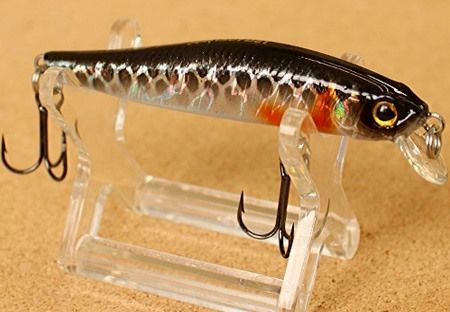
2.Shads. Light wobblers of Scandinavian origin. The flat body is thickened in the anterior part. Create a provocation for a quick attack. They have a pronounced game. Suitable for reservoirs both with and without current. The most catchy ones are in early spring and autumn.
3. Cranks. Ideal for beginner spinners, since to use them you do not need to know the special intricacies of wiring. They are distinguished by active play in the water. Due to the long-distance casting system, they are able to attract a predator from a great distance.
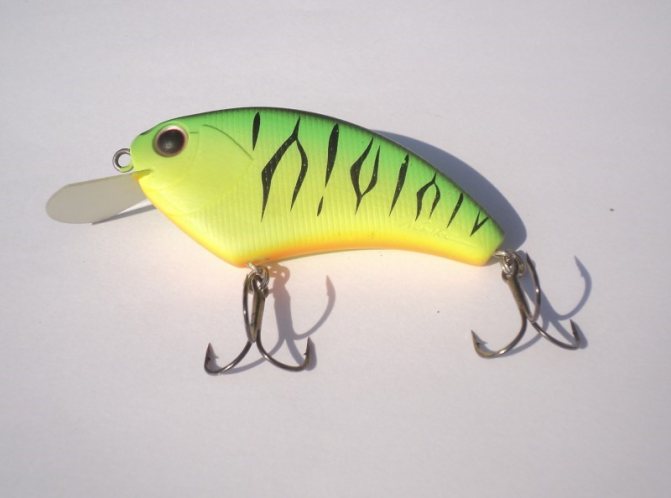
4. Fats. Made in the shape of insects (grasshoppers, beetles) or small fish with bulging eyes. They are in demand among pike, pike perch and even carp. Wiring to the fat should be fast and intermittent.
If you set priorities, then the most popular among fishermen is the minnow model - an imitation of whitebait. It is this series of wobblers that is among the top light baits with the greatest catchability.
A little theory...
In my opinion, spinning players are divided into three types. The first is a complete denial of any companies or brands when choosing artificial baits (in our case, wobblers). The second is a kind of “deification” of a specific bait, a fanatical attitude towards its color, and a complete denial of replacing any parts of this bait. For example, it is impossible to change the tees of a wobbler, simply because the family has already exhausted its resource: “What are you... the game will change, the wobbler will no longer catch as well as before...” A similar attitude can be traced to the winding rings, and, of course, to the presence of “ anti-pike leash. The bait rises to the rank of a living being... So it’s not far from talking with it...
And finally, the third type is located between the previous two. He has a balanced, reasonable approach to choosing bait. Not considering a specific model of wobbler as a “cure for all diseases,” he is inclined to believe that, first of all, the reaction of a predator to an object of hunting or irritation depends on a specific body of water, weather, the mood of the fish itself... But at the same time, he sensibly assesses when Under certain conditions, one wobbler is significantly superior to another, even if outwardly very similar to the first. Reasonability lies in everything: if the use of a leash is justified, the spinning angler will fish with it, but if he feels that because of this particular element the number of bites from “non-toothy” fish has significantly decreased, get rid of it. And, of course, he will exchange blunt tees for sharp ones, if only because a dull hook is no longer a hook.
I won’t undertake to judge whether this is good or bad, but among spinning players the first and second groups of wobbler fans are in the lead by a confident margin. But the third group is not in opposition either. She is confidently replenishing her ranks, although she is still hopelessly behind the first two. But it can’t be any other way - if you haven’t been to the first and second, you will never be accepted into the third. Your own life experience cannot be replaced by reading articles or conversations with other fishermen.
So, let's move from theory to practice.
Benefits of use
The increased interest of fishing enthusiasts and experts in such wobblers is based on a number of advantages, which is reflected in the quality of fishing. Among them:
- Large selection of trophies. Using light type baits you can catch small, up to 2 kg, pike, carp, pike perch, carp, trout, chub, perch and even large crucian carp.
- Increased sensitivity of the wobbler. Provides the opportunity for the fisherman to react to a bite with lightning speed. Reduces the number of fish hatches.
- Suitable for fishing in still water (pond, lake) and for reservoirs with fast currents (river, bays).
- When casting it stays in the horizon. It flies smoothly without tangling the tackle. Most models are equipped with a long-distance casting system.
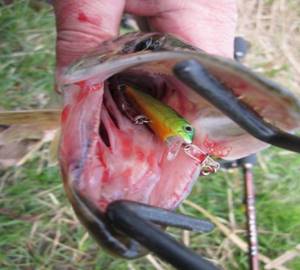
As for the wiring, it is individual for each type of wobbler. It can be either uniform, twitching (supporting) or stop-and-go.
But the depth of the reservoir should not be great. Ultralights are most effective in shallow water.
The best diving wobblers “ultralight”:
Megabass Live-X Smolt
Length - 48 mm, class - suspender. Working depth 1.5-2 m. An excellent wobbler for fishing with classic twitching at this depth. Thanks to one single ball in the central tail part, this wobbler works wonders when jerking. Due to the fact that this particular ball moves easily along special grooves in the body cavity, the wobbler has a very rich game. Sometimes you notice that during the next jerk it turns over 180 degrees relative to its longitudinal axis. Rare wobblers perform such pirouettes, especially in the ultralight class. It is difficult to say whether this is a decisive factor, but the “striped” has a great affinity for this bait.
Live-X works well both with monotonous “powerful” twitching and with jerks alternating with pauses.
Competition practice: one of the best wobblers when fishing at a depth of up to 2.5 m on the Volga river (Saratov region). A small part of the fish, both at the World Championship qualifiers in 2007 and at the final stage of the RSL in the same year, were caught on this particular model. And if I spent most of my time catching perch from such (and not from shallower) depths, then I would have caught significantly more on Live-X.
Tackle House Buffet SD43
I got this small wobbler at a time when I was actively improving my trout spinning skills. At first it was fishing only in still water for “economic” trout near Moscow, and then the qualifying competitions for the World Championship, held in a similar reservoir in the Leningrad region. And finally, Buffet saw “wild” nature only in Slovakia, during training for the championship itself.
At that time, I had more negativity than positivity towards this bait. She caught mediocre trout, held the same stream, and besides, she flew one and a half times closer than the champion in this category - the 35th “Ridge”.
Then I even liked not the deep-sea version of this wobbler, but the regular “Buffitt” with a small blade. He caught trout much better.
But it was Buffet SD, at the final fourth stage of the RSL, held in the Saratov region, that showed its far from childish ability to “knock out” all the perch without a trace. Moreover, what is especially noteworthy here is that if we talk about catching a standard “striper” weighing 60-150 g, there were no advantages that would force one to fish with the Buffet. But as soon as the bulk of the perch were below the bottom line, it felt like Buffet was catching everyone.
There is one more distinctive feature of this wobbler (it was also noticed by Artem Mishin). The point is that Deep is very convenient to play in almost one place, for example, under your feet. This helps a lot when the perch goes after the wobbler, but does not dare to attack. Or when fishing in cramped conditions, for example, small snags in rivers. When it is very difficult to cast, you can only lower and float the sinking wobbler a little under the snag you like. It has been noticed that the vast majority of sinking wobblers are afraid of perch, or rather, afraid of their free-diving phase. In our case, the situation is the opposite: there is a minimum of fear - the free diving phase of Buffet attracts, including very passive perches.
Smith Still SP
Also a unique wobbler of its kind. This is the smallest wobbler, both in length and overall dimensions, which belongs to the suspender category, and at the same time goes deep to 1.5 m. Hence all its advantages. We need a suspender to stir up passive fish. The minimum dimensions are perfect for the most capricious or small predator. And its deepening is, in its own way, unique. Accordingly, when all these three parameters converge, without hesitation, we install Still with full confidence in its unsurpassed performance qualities.
I have many examples (though not under competition conditions) where no other suspending minnow could compete with it.
Two or three years ago, this wobbler showed itself excellently at the internal competitions of the Vympel club. The perch that day was caught exclusively small (no more than 50 g), and it stayed at a depth of 1.5-2 m. And this was the only wobbler that he was interested in, appearing from behind the shelters. That day, I and other athletes completely tried the entire range of micro-lures, but this particular model turned out to be the best.
And in 2007, at the RSL competition on the river. Kotorosl, Maxim Selivanov took a worthy place, catching a fish on Still. The bite then (as indeed before) was very capricious, and many participants were unable to get away from zero in six hours of fishing.
Quite a few pike were caught using this model on small rivers. Sometimes a small pike is completely passive, one might say, standing in a daze, but still reacts to Still.
OSP Dunk 48 SP
A very worthy wobbler. Of course, with a very big stretch it can be classified as ultralight. But I can’t help but mention him.
This is the only wobbler that I had at my disposal during the preparation for the World Championship in Saratov. With its rather impressive dimensions, it regularly caught decent perch from a depth of more than 2 m. And at the World Championship itself, this wobbler clearly did not gather dust in the box - few, but almost the largest, specimens of “stripers” were caught with it. The Dunk 48 SP is good because it quickly reaches its working depth, which is very important when casting.
The situation is approximately the following. If medium-sized perches are caught from shallower depths or with other wobblers, then on the 48th Dunk only those larger than 200 g are caught. It is clear that there are much fewer of them, but there is a situation when others are caught, and the “larger ones” for one reason or another For other reasons it refuses to peck. On the Volga river near Saratov, I found a simple solution - you put this wobbler, and if the first two runs were in vain, you realize that there is no one there anymore...
But I ask you not to take everything literally. There are exceptions to any rule. The Dunk does not always and not always catch only “humpbacks”, but the fact that larger “striped” ones bite on it is a fact.
I advise you to diversify the wiring of this wobbler as much as possible. Alternate powerful jerks with gentle stretches, long pauses with speed runs. It was this chaotic style of animation that seemed most successful to me.
Pontoon 21 Cheerful 40 F
To be honest, this wobbler has not won more than one competition. But I haven’t had time to participate in any of them yet. Having appeared on the Russian market towards the end of last year, it immediately won a positive assessment from many spinning rod masters. “But it is impossible to grasp the immensity,” - this is exactly how I tried to begin the answer to the question about its catchiness.
But in just a few trips I made up for the “gap in my arsenal,” which was facilitated by the opinions of my spinning friends. Now the winter and spring season are almost behind us. And, it is worth noting that after such a successful debut, without mentioning this model, I cannot close such a topic. I see strength and great opportunities in it... Fortunately, the “input parameters” lead exactly to this.
The wobbler is available in two versions - floating and suspended. Both modifications fully reflect its name. Cheerful - translated from English means energetic, cheerful, “dispelling gloom”... And all these definitions fully correspond to our “microshed”: it has a very rich game. Just a slight movement of the rod tip is enough to make the wobbler literally perform several pirouettes on the spot. But this is not its main difference. The most important thing is hidden in the balance of this baby. The fact is that no jet is capable of throwing it on its side, much less putting it into a tailspin. Imagine how valuable this is when fishing in the current! The balancing of the bait is so precisely selected that even when passing through a so-called drain, for example, from a dam, the wobbler is not carried away by the current. He continues to stubbornly resist and strive to go deeper and deeper.
I’m not afraid of this word - this is the best model of the Deep class “Shads” in terms of combination of performance, catchability and price.
It’s difficult to say whether this model catches more perch, but with another predator, which we are mostly accustomed to calling bycatch, the situation is very good. Asp, chub and pike are very interested in Cheerful. There was no fishing (we are talking about the Pekhorka River) without us catching either several “white” predators or a pike. One of the spotted beauties even pulled 3.7 kg….
Ultralight and wobblers are exciting
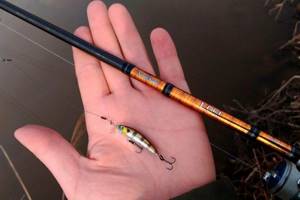
Fishing on the move
A spinner using ultralight wobblers is easy to spot on any shore. A fisherman with light tackle moves constantly and casts very actively . This method of fishing makes it possible to get even into hard-to-reach places, you just need to cast the bait more accurately. Ultralight masters use different types of artificial baits:
- spinners;
- soft fish;
- fly fishing flies;
- wobblers; this bait is now considered the most popular; Even hybrids are made from it - fly wobblers on some reservoirs can be very catchy.
It is believed that it was the use of wobblers that raised ultralight fishing to the current level and even made it a separate, but very entertaining type of fishing. We’ll talk about this type of fishing today.
Bait buoyancy
Catching ultralight wobblers have a main distinctive feature - they are stable in any horizon that is set during casting. It is the buoyancy and sensitivity of wobblers that are their attractive qualities for fishermen in this category. Catching ultralight wobblers have their own classification based on buoyancy:
- floating baits; they remain afloat after falling into the water, and their activity completely depends on the behavior of the spinner; They are most catchy in the spring;
- sinking models; after casting, they slowly sink to the bottom; It is advisable to use them in reservoirs where there are no snags and the bottom is not overgrown with abundant vegetation; Most often, these baits are used in the fall, when the bottom becomes cleaner;
- suspenders; their buoyancy is considered neutral, however, fishing with these baits requires certain skills from the fisherman, but it gives the best results; It should be noted that such baits can scare away active fish (for example, perch).
As a rule, when fishing with ultralight, fishing is done in a straight line, so the depth of the bait plays a special role.
Expert opinion
Knipovich Nikolai Mikhailovich
Zoologist, hydrobiologist. I am interested in fishing at a professional level.
Important! Sometimes the bite stops completely at a certain depth, then you have to vary it by adding special springs, latches and loops, this has to be done right on the shore, so a fisherman using the lightest gear must be well equipped.
In general, catching ultralight with wobblers requires knowledge of many fishing details, which will then lead to success.
Choosing a coil for “ultralight”
A spinning spinning reel is generally a very thin tool, especially an ultralight reel. Spinning rods are short, very light, small baits, thin fishing lines - all this completely eliminates a heavy reel that is disproportionate to the parameters of the tackle. Only she alone can cancel out all the efforts and painful selection of a first-class fishing rod...
Much depends on the thickness of the wallet. My opinion is this: at the moment, the absolute leaders in the construction of spinning reels are the Daiwa company. Good “dive” reels cost a lot of money. Of course, one of the best options would be to buy a Daiwa Exist 2506 or 2508 model, which will cost no less than $900. The next step would be Daiwa Certate 2506 Finesse Custom. Its price is at least $500. And “closes the series” is the Caldia KIX 2506 model, the ownership of which will cost no less than $200.
Unfortunately, until recently everything ended in this price range. But, fortunately, not so long ago the Banax company, following a progressive path of development, presented its new development to the Russian consumer. A specialized model for ultralight in the most affordable price range. And I must say I hit the nail on the head. The new Banax Ares 600 model costs less than 2,500 rubles. It is gratifying to note that a specialized ultralight reel has appeared in a price range accessible to most Russian buyers. True, so far the only one of its kind...
Ultralight rod
Anglers continue to argue about the upper limit of the ultralight spinning rod test.
Some insist that a rod with a test weight exceeding 6 g has nothing to do with ultralight; according to others, the maximum limit is 12 g. Looking at such a confrontation between the two camps, manufacturers decided to divide ultralight rods into two categories. It should be noted that the “ultralight” prefix is not suitable for every lightweight spinning rod. One test is not enough here; the rod must have several more important characteristics, such as:
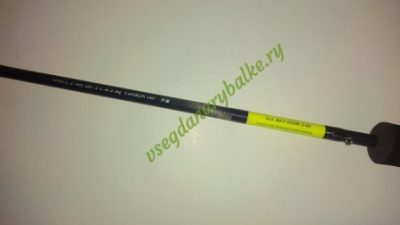
high quality of the form itself and accessories;- flawless assembly;
- increased sensitivity;
- possibility of long-range and accurate throw.
And this is not someone’s whim, but an extreme necessity, because you often have to catch trophy fish that are tempted by micro-bait. The slightest flaw and instead of joyful experiences, the fisherman will face deep disappointment at the sight of a broken spinning rod. In other words, even an externally seemingly fragile fishing rod must have a certain margin of safety.
Regarding the length, today there is also no consensus. Among the ultralights there are both short ones up to 1.5 meters, and “long ones” that slightly fall short of 3 meters. When you are in a fishing store and thinking about how long to take a spinning rod, first of all you need to take into account the specifics of the reservoir on which it will be used.
For example, when fishing on a narrow river with heavily overgrown banks, it is problematic to use a 2.4-meter rod, or even completely impossible. For such conditions, a 1.5-meter tool is required. On wide rivers and large bays the opposite is true - the longer the spinning rod, the better. Of course, within reasonable limits.
Experienced fans of ultralight fishing advise paying attention to medium-fast spinning rods; they have good sensitivity and deliver the bait exactly to the intended location. The regular-fast class rod is the best for microjigs, wobblers and spinners. It throws far and accurately, absorbs jerks perfectly, and control of the bait is also excellent. For “refined” fishing these are invaluable qualities.
On the first point, some anglers may object. They say, all this is good, but why do you need long-distance casting in the ultralight? Moreover, you still can’t throw a bait weighing 2-3 g over a hundred meters, no matter how hard you try. On the one hand, everything seems to be correct, but on the other hand, the ability to throw a miniature twister or spinner 40 meters instead of 20 will not be superfluous.
Advantages of ultralight
Ultralight rods were invented specifically for fishing in small bodies of water (bay lakes, rivulets, streams), where using a standard spinning rod is uncomfortable, if not completely impossible. They did not immediately become popular, because most fishermen did not even imagine that in some “ditch” they could catch a decent pike or chub.
Everyone was striving for vast reservoirs and large rivers. Because of this, large bodies of water began to experience enormous pressure, catches decreased noticeably, and therefore interest in shallow rivers revived. The fish that enter them (often larger than normal size) have become a coveted object of fishing. This is where fishermen remembered the existence of ultralight.
https://www.youtube.com/watch?v=orK0lrCnUe4
A light spinning rod turned out to be an indispensable tool for fishing in narrow rivers, flooded lakes in shallow coastal waters. The fact is that such places are full of fry, the predator does not lack food, so it is capricious and refuses to take classic spinning baits. But as soon as you offer him a microbait, the situation immediately changes. Proper play and small dimensions fulfill their purpose - they provoke both predatory fish and some peaceful species to attack.
Minnow Series
- The Japanese-made floating minnow Sugar Minnow 40F is a very good bait for rivers with moderate currents, and you need to fish using the Stop-end-Go technique, that is, jerking. The catchability of this model is very exciting, because it is caught by pike, perch, chub, asp and even ide.
- Sinking models. Due to their greater mass than floating minnows, they allow aggressive twitching and fairly long casts. There are also fast-sinking wobblers that sink to depths like a stone. They are great for fishing in strong currents or for reconnaissance.
We suggest you familiarize yourself with: Wobblers for trout, choosing gear and bait
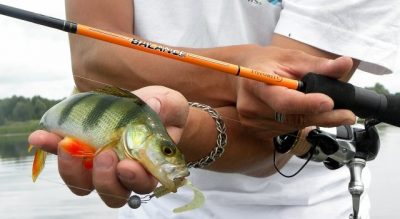
The diving minnow is considered universal. It has a diving blade and is capable of playing independently during a calm retrieve, and also behaves well during a jerking retrieve, you just need to feel the force of the jerk. By changing the angle of the rod to the plane of the water, you can fish at depths in the middle ranges and even in the upper layers of the water column.
The amplitude of the “game” of a diving minnow is much wider than that of all other types, and it is due to this that this type of bait is able to attract even the most “sluggish” fish.
Walkers:
Angler's Republic Rapid Pencil Type-1
There are two versions of this walker, which look no different. These are Pencil Type-1 and Type-2. Both are floating, only the first is 0.2 g lighter than the second, and is oriented slightly differently in the water. Type-1 lies almost entirely on the surface, while Type-2 only has its front part visible, like a loaded float. Hence the different properties. The second flies a little further, but it seemed to me that it was also a little more difficult to control. And the first one flies closer, but is easier to fly. There is one more drawback of Type-2 - with a small side wave (ripple), it tends to dive under it, which does not happen with Type-1. Based on all this, I am more impressed by the “first type”.
No matter how trite it sounds, the most effective wiring is the constant monotonous wagging of the walker from side to side. Try to avoid disruptions in the monotonous movements of the bait to the right and left, this will definitely negatively affect the accompanying predator. In theory, the situation should be the opposite: interest, pursuit, stop and then attack. But in practice, in 80% of cases, exactly the opposite happens. The predator turns around and swims away. This can be attributed to perch to a lesser extent. As a rule, they are chased by a pack, and, as a rule, until the “victorious end”.
Mikhail Kaledin opened my eyes to this bait when he and I were preparing for the next stage of the RSL, fishing in the same boat. Yes, this walker was biting, but at the same time, I caught just as much with wobblers. Everything changed when, on the first day of the fourth stage of the RSL in 2007 at the Volgograd reservoir, Alexey Markov “blown me to smithereens.” He fished with just this walker (Type-2 only), and I fished with minnow wobblers. On the second day, I turned out to be more prepared and borrowed Mikhail’s “cherished violin,” with which I caught more than half of the perches, becoming first after two rounds.
Smith Towadi
Length 43 mm, weight 1.8 g. This is the smallest, properly working walker that I have ever fished with. The bait is capable of getting you out of seemingly hopeless situations, when the perch is simply not visible, it does not react to wobblers, rubber, spinners, but you put the Towadi and right before your eyes the situation changes radically. Out of nowhere, keel waves appear from literally all sides. Moreover, the perch reacts to other surface baits, but much worse, and it is already very bad to hook the hooks.
Walker, according to the classics, works in the warmest water, and if you don’t need to cast far (this little guy flies only 15-20 m maximum), and the mood of the perch is far from perky, this micro-walker will catch everyone who is at least able to move a little fins towards him.
Thanks to this bait, Maxim Dydykin won a silver medal at the fourth stage of the RSL in 2007. And if he hadn’t wasted time helping me, Dmitry Tretyakov and Elena Dydykina, I’m sure I would have been a champion!
Do not forget that effective fishing with such a small walker is possible only with the use of the lightest gear. It’s just that in order for the bait to be retrieved successfully, you need to feel the bait, which is very difficult to do with an inharmoniously selected rod and reel. My favorite and most suitable spinning rod for walkers of this class is the Black Hole Hi-Light with a length of 1.98 m and a test of 2-7 g, which is well suited for all the wobblers described above. There are, of course, other spinning rods that have gone through the same lengthy “screening” as all these baits, but since the article is not about them, I will now only allow myself to list the rest of my favorite ultralight rods. These are: Tenryu Juvia 2.1 m, 2-8 g; Black Hole Hi-Light 2.1 m, 3-12 g; Tenryu Lunakia 2.19 m, 0.8-5 g.
In the second part you will find a continuation of the review of micro baits with brief tips on choosing spinning reels.
In my opinion, spinning players are divided into three types. The first is a complete denial of any companies or brands when choosing artificial baits (in our case, wobblers). The second is a kind of “deification” of a specific bait, a fanatical attitude towards its color, and a complete denial of replacing any parts of this bait. For example, it is impossible to change the tees of a wobbler, simply because the family has already exhausted its resource: “What are you... the game will change, the wobbler will no longer catch as well as before...” A similar attitude can be traced to the winding rings, and, of course, to the presence of “ anti-pike leash. The bait rises to the rank of a living being... So it’s not far from talking with it...
And finally, the third type is located between the previous two. He has a balanced, reasonable approach to choosing bait. Not considering a specific model of wobbler as a “cure for all diseases,” he is inclined to believe that, first of all, the reaction of a predator to an object of hunting or irritation depends on a specific body of water, weather, the mood of the fish itself... But at the same time, he sensibly assesses when Under certain conditions, one wobbler is significantly superior to another, even if outwardly very similar to the first. Reasonability lies in everything: if the use of a leash is justified, the spinning angler will fish with it, but if he feels that because of this particular element the number of bites from “non-toothy” fish has significantly decreased, get rid of it. And, of course, he will exchange blunt tees for sharp ones, if only because a dull hook is no longer a hook.
I won’t undertake to judge whether this is good or bad, but among spinning players the first and second groups of wobbler fans are in the lead by a confident margin. But the third group is not in opposition either. She is confidently replenishing her ranks, although she is still hopelessly behind the first two. But it can’t be any other way - if you haven’t been to the first and second, you will never be accepted into the third. Your own life experience cannot be replaced by reading articles or conversations with other fishermen.
So, let's move from theory to practice.
Tackle House Buffet SD43
I got this small wobbler at a time when I was actively improving my trout spinning skills. At first it was fishing only in still water for “economic” trout near Moscow, and then the qualifying competitions for the World Championship, held in a similar reservoir in the Leningrad region. And finally, Buffet saw “wild” nature only in Slovakia, during training for the championship itself.
At that time, I had more negativity than positivity towards this bait. She caught mediocre trout, held the same stream, and besides, she flew one and a half times closer than the champion in this category - the 35th “Ridge”.
Then I even liked not the deep-sea version of this wobbler, but the regular “Buffitt” with a small blade. He caught trout much better.
But it was Buffet SD, at the final fourth stage of the RSL, held in the Saratov region, that showed its far from childish ability to “knock out” all the perch without a trace. Moreover, what is especially noteworthy here is that if we talk about catching a standard “striper” weighing 60-150 g, there were no advantages that would force one to fish with the Buffet. But as soon as the bulk of the perch were below the bottom line, it felt like Buffet was catching everyone.
There is one more distinctive feature of this wobbler (it was also noticed by Artem Mishin). The point is that Deep is very convenient to play in almost one place, for example, under your feet. This helps a lot when the perch goes after the wobbler, but does not dare to attack. Or when fishing in cramped conditions, for example, small snags in rivers. When it is very difficult to cast, you can only lower and float the sinking wobbler a little under the snag you like. It has been noticed that the vast majority of sinking wobblers are afraid of perch, or rather, afraid of their free-diving phase. In our case, the situation is the opposite: there is a minimum of fear - the free diving phase of Buffet attracts, including very passive perches.
Smith Still SP
Also a unique wobbler of its kind. This is the smallest wobbler, both in length and overall dimensions, which belongs to the suspender category, and at the same time goes deep to 1.5 m. Hence all its advantages. We need a suspender to stir up passive fish. The minimum dimensions are perfect for the most capricious or small predator. And its deepening is, in its own way, unique. Accordingly, when all these three parameters converge, without hesitation, we install Still with full confidence in its unsurpassed performance qualities.
I have many examples (though not under competition conditions) where no other suspending minnow could compete with it.
Two or three years ago, this wobbler showed itself excellently at the internal competitions of the Vympel club. The perch that day was caught exclusively small (no more than 50 g), and it stayed at a depth of 1.5-2 m. And this was the only wobbler that he was interested in, appearing from behind the shelters. That day, I and other athletes completely tried the entire range of micro-lures, but this particular model turned out to be the best.
And in 2007, at the RSL competition on the river. Kotorosl, Maxim Selivanov took a worthy place, catching a fish on Still. The bite then (as indeed before) was very capricious, and many participants were unable to get away from zero in six hours of fishing.
Quite a few pike were caught using this model on small rivers. Sometimes a small pike is completely passive, one might say, standing in a daze, but still reacts to Still.
Tackle House Twinkle 45F
Classic trout “wood”... Almost the most expensive! In some stores the price for it exceeds the thousand ruble mark. Previously, I did not understand it, as it seemed to me then, to be overpriced. I didn’t understand until one incident during the World Trout Fishing Championship in Slovakia in 2007. At one of the training sessions, Maxim Balachevtsev, by simply sorting through it, got what was then a “simply expensive” wobbler. Literally half an hour later, Alexander Vorobyov and I realized that if we fish with wobblers during the competition, it should be Twinkle... The next day or two I tried to refute this theory, but in vain. Thus, before the start, Maxim had to share one Twinkle... Fortunately, he had several of them. And I only had a Twinkle Deep Dive 45F, which, by the way, I fished with throughout the second day of the competition. On the very first day I fished almost all the time with the shallow-water model of this wobbler. Why is this so? The answer is simple: on the first day I got a shallow water zone, and on the second they expected a depth of up to 1.5 m.
I don’t presume to speculate on what the secret of this wobbler is, I’ll just say that the material from which Twinkle is made leaves its “imprint” on its performance characteristics. It has a very fast start (you can play on the spot even with a weak current) and very active play with soft twitching. This is just a visual feeling of how everything really happens, it’s probably worth asking the trout.
And finally - one very interesting pattern. In addition to the 45th model, we had several 60 mm long wobblers. And what is very strange is that only large trout (from 400 g) pecked at them. During the last day of training, we managed to catch several decent fish with them. And 20 minutes before the end of the first round (when I tore off the only 45 “Twinkle”), having placed the 60, on the second retrieve I got a bite from a trout weighing about a kilogram. This is where the experiment ended: I never saw a wobbler or a trout again...
Megabass X-55 SP
This wobbler captivated everyone: both anglers and perches and pikes. First of all, with its “maximum realism” in movements and “depth” of colors. Back in 2005, as soon as this model went on sale, I appreciated it. And even then he actively used this wobbler at various competitions. And in 2006, at the Russian championship, I caught at least a quarter of the total catch with it. Largely thanks to him, our team became the national champion.
It looks like a very classic minnow shape, a small blade, attractive colors. Very standard combinations, right? Apparently, all the most interesting things are hidden from human eyes. Otherwise, how else can we explain the phenomenal catchability and its superiority over other models in some situations. It is probably the thoughtfulness of every detail that distinguishes Megabass products.
You should pay attention to one important detail. Hundreds of perches have been caught with it, the tees are still original, and there is no desire to replace or sharpen them, they have retained their original sharpness.
OSP Dunk 48 SP
A very worthy wobbler. Of course, with a very big stretch it can be classified as ultralight. But I can’t help but mention him.
This is the only wobbler that I had at my disposal during the preparation for the World Championship in Saratov. With its rather impressive dimensions, it regularly caught decent perch from a depth of more than 2 m. And at the World Championship itself, this wobbler clearly did not gather dust in the box - few, but almost the largest, specimens of “stripers” were caught with it. The Dunk 48 SP is good because it quickly reaches its working depth, which is very important when casting.
The situation is approximately the following. If medium-sized perches are caught from shallower depths or with other wobblers, then on the 48th Dunk only those larger than 200 g are caught. It is clear that there are much fewer of them, but there is a situation when others are caught, and the “larger ones” for one reason or another For other reasons it refuses to peck. On the Volga river near Saratov, I found a simple solution - you put this wobbler, and if the first two runs were in vain, you realize that there is no one there anymore...
But I ask you not to take everything literally. There are exceptions to any rule. The Dunk does not always and not always catch only “humpbacks”, but the fact that larger “striped” ones bite on it is a fact.
I advise you to diversify the wiring of this wobbler as much as possible. Alternate powerful jerks with gentle stretches, long pauses with speed runs. It was this chaotic style of animation that seemed most successful to me.
Smith Luna 47S
Another well-known model that has long won the genuine sympathy of spinners. With monotonous twitching in still water, the working horizon of this wobbler ranges from 0.8 to 1.2 m. When retrieving with pauses, it can go a little deeper. In addition to perch, trout fishing is very good. These are precisely the two directions in which the working qualities of this model are most fully revealed.
I also noticed that if there is a pike in the fishing area, no matter what size, the reaction to the wobbler will, as a rule, be positive. The same cannot be said about the vast majority of other microwobblers.
It is the sinking version that works very well in the rapid flow of a mountain river. A small shoulder blade combined with decent weight and a strong body do the job. This wobbler is very, very attractive for trout. At the World Championships in Slovakia, his hands did not reach him, but during training he was selected for the “killer box”. Works well in combination with monofilament and soft twitching.
But as for perch, Luna still has more victories (at least for me). I caught 30 percent of the total mass of perches at the Moscow Dawns - 2006 competition with it. And he became the first. And if you consider that the remaining 70% were caught exclusively with jigs... It was thanks to “Luna” that Maxim Dydykin climbed to the podium at the 4th stage of the RSL Top Division in 2005.
Pontoon 21 Cheerful 40F
To be honest, this wobbler has not won more than one competition. But I haven’t had time to participate in any of them yet. Having appeared on the Russian market towards the end of last year, it immediately won a positive assessment from many spinning rod masters. “But it is impossible to grasp the immensity,” - this is exactly how I tried to begin the answer to the question about its catchiness.
But in just a few trips I made up for the “gap in my arsenal,” which was facilitated by the opinions of my spinning friends. Now the winter and spring season are almost behind us. And, it is worth noting that after such a successful debut, without mentioning this model, I cannot close such a topic. I see strength and great opportunities in it... Fortunately, the “input parameters” lead exactly to this.
The wobbler is available in two versions - floating and suspended. Both modifications fully reflect its name. Cheerful - translated from English means energetic, cheerful, “dispelling gloom”... And all these definitions fully correspond to our “microshed”: it has a very rich game. Just a slight movement of the rod tip is enough to make the wobbler literally perform several pirouettes on the spot. But this is not its main difference. The most important thing is hidden in the balance of this baby. The fact is that no jet is capable of throwing it on its side, much less putting it into a tailspin. Imagine how valuable this is when fishing in the current! The balancing of the bait is so precisely selected that even when passing through a so-called drain, for example, from a dam, the wobbler is not carried away by the current. He continues to stubbornly resist and strive to go deeper and deeper.
I’m not afraid of this word - this is the best model of the Deep class “Shads” in terms of combination of performance, catchability and price.
It’s difficult to say whether this model catches more perch, but with another predator, which we are mostly accustomed to calling bycatch, the situation is very good. Asp, chub and pike are very interested in Cheerful. There was no fishing (we are talking about the Pekhorka River) without us catching either several “white” predators or a pike. One of the spotted beauties even pulled 3.7 kg….
Ultralight reels
If this element is chosen incorrectly, the overall balance of the gear is disrupted, which is simply unacceptable in delicate ultralight fishing. Therefore, the lightest reels are selected, weighing no more than 200 g, with a spool in the range of 1000-1500. There are other requirements that are no less important than weight and dimensions. We are talking about the quality of line winding and the reliability of the friction brake.
We suggest you familiarize yourself with: Catchy wobblers for pike in autumn
Budget models, the internal parts of which are made of plastic and other fragile materials, do not always meet these requirements. While saving on a reel, fishermen are often faced with the problem of an unexpected breakdown of the mechanism right on the pond, and for no apparent reason. It’s good if you have a spare reel, but if not, then you’ll have to return home without a catch and without the mood.
A good reel can be found in the mid-price category, for example, from Daiwa or Mitchell. With proper use and proper care, they last for more than one season and never fail.
There are different ways of ultralight fishing using almost all the same baits as in classic spinning fishing. The most popular are turntables, so we’ll start with them.
Rotating spoons are the leaders among ultralight baits. There are axial and non-axial micro-spinners on sale in sizes from 1 to 00, which provoke not only predators to grab. As you know, with ultralight it is possible to catch peaceful fish, and quite successfully. The temptingly playing miniature petal will not be missed by the rudd, and with a meager food supply, it is tempted by heavy roaches and crucian carp.
So, we've sorted out the sizes, now as for the colors.
According to most experts, light-colored micro-spinners, as well as those with red dots on a light background, can be considered universal in this type of fishing. At the same time, spinners with a dark petal can also “shoot” in a particular body of water, despite the fact that this color does not exactly imitate the fry.
Most likely, the predator perceives them as something edible, subject to immediate attack and consumption. Conclusion: the box should contain micropinwheels of various colors, then no capriciousness of the fish will affect the result.
for ultralight fishing - small artificial fish with a depth of no more than 1.5 meters. Their weight is 2-3 g, length does not exceed 3 centimeters. As for the geometry of the bait’s body, minnows, cranks and feta are appropriate for ultralight fishing on the river. Microwobblers can be floating, sinking or suspended, the buoyancy is selected for a specific fish.
Silicone baits of small sizes occupy third position in the ranking of the best. Microjig can be considered as a separate and even independent direction in ultralight fishing, allowing you to effectively hunt perch, pike and chub in the coastal zone. You can effectively catch the listed predators using miniature vibrotails, twisters, leeches, choosing the color depending on the mood of the fish and the weather.
Ultralight fishing involves targeted casting and fishing of a promising area in a short period of time. If within 10 minutes the fish has not responded to any of the proposed baits, you need to look for another place. It happens that the object of fishing reveals its presence, but does not want to peck. In this case, you should experiment with feeding the bait, speed up the retrieve or, on the contrary, slow it down.
We suggest you familiarize yourself with: The strongest knot for a hook - RibaZdes
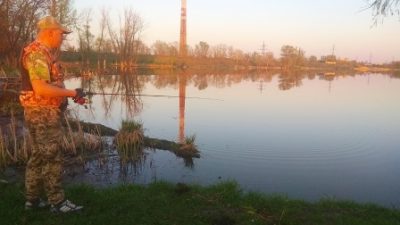
When casting for the first time, it is important not to scare off the fish, but to try to attract its attention. To do this, the bait is smoothly fed into the water near the expected parking (ambush) site of the predator. On the first retrieves, it makes sense to change the horizon through various manipulations with the rod. The artificial fish will walk near the surface, in the middle layers, above the very bottom, as if looking for its prey. Thanks to this trick, after a few bites (or pokes) it will become clear what to do next.

